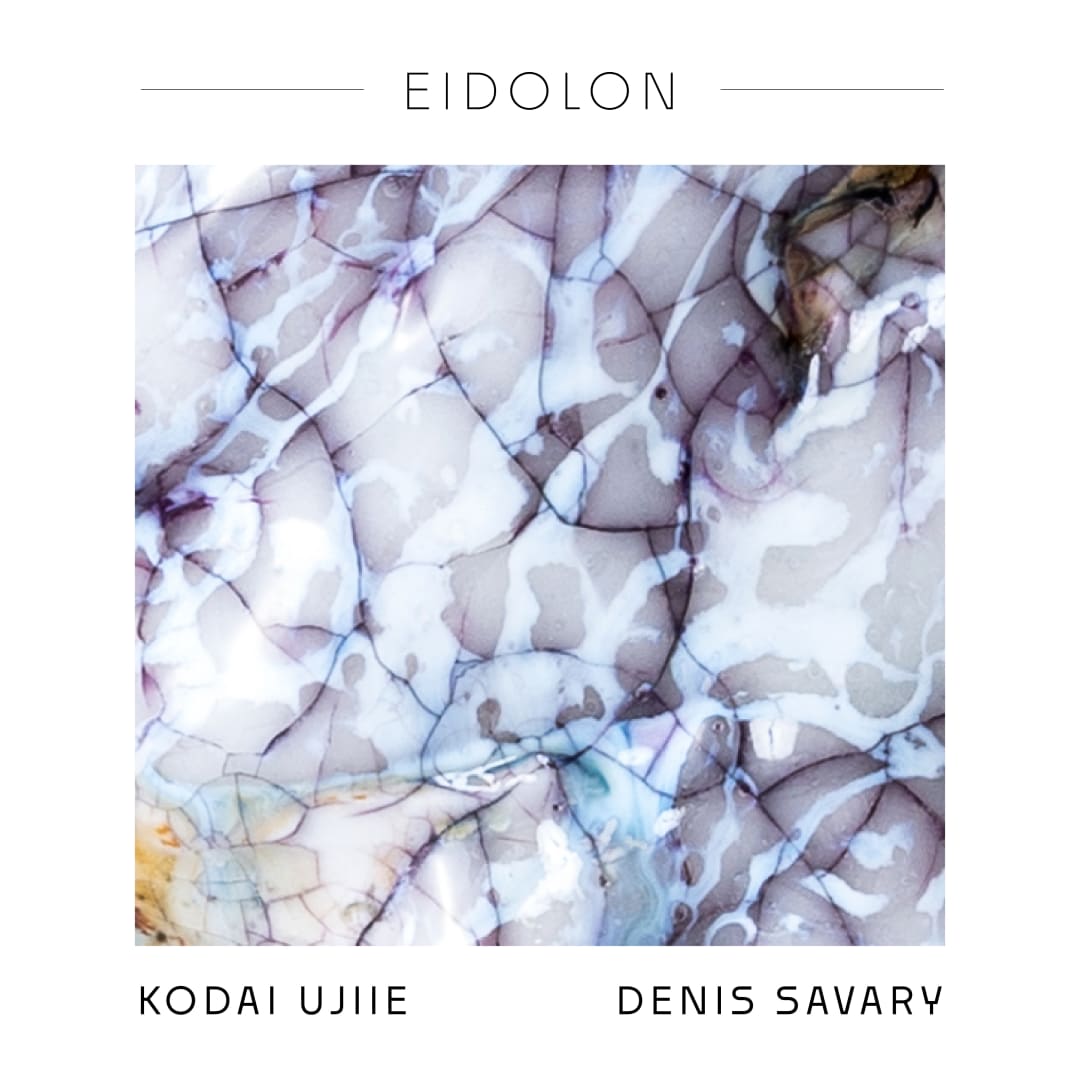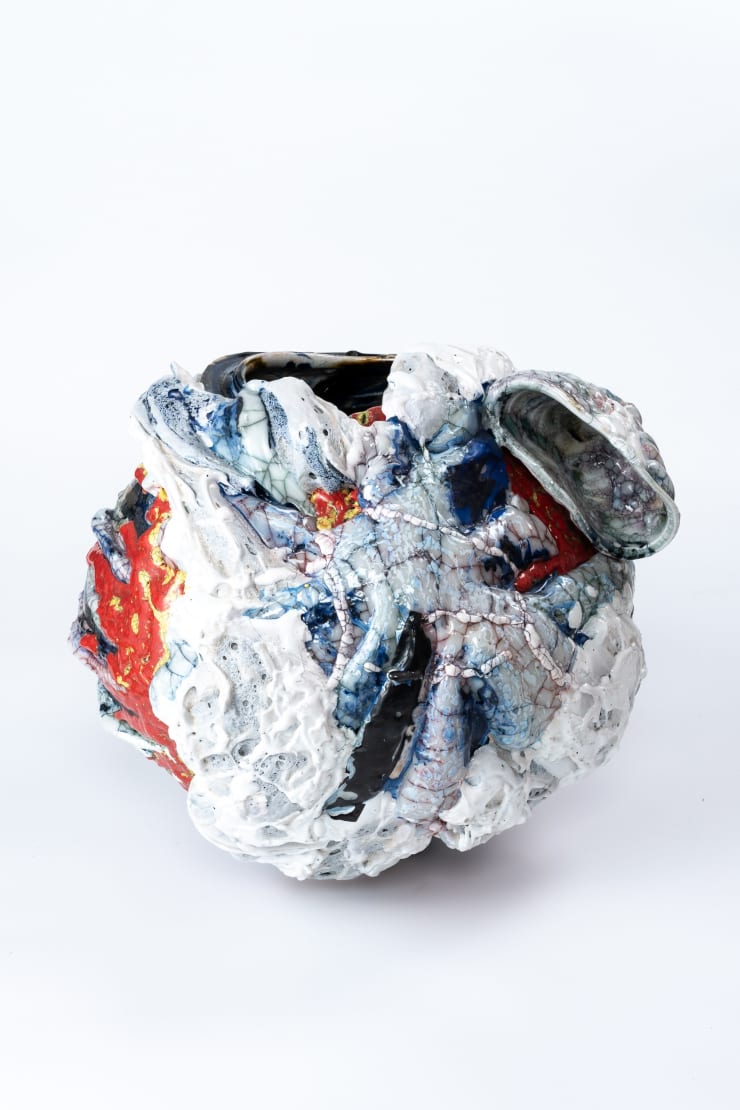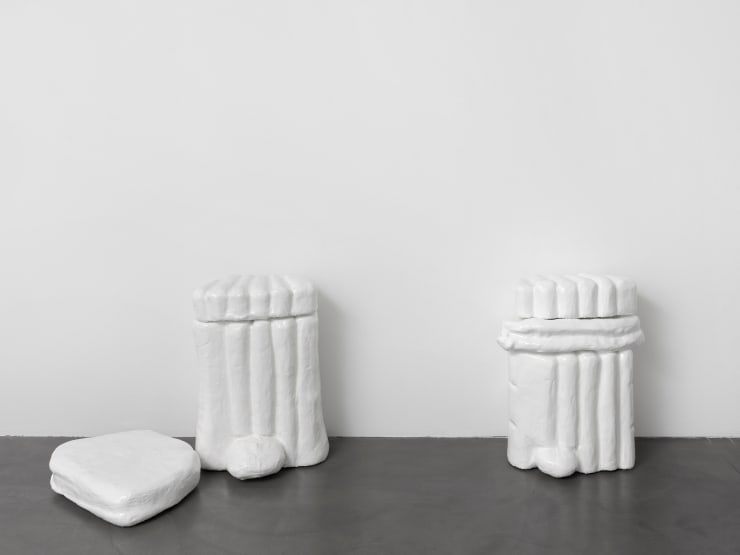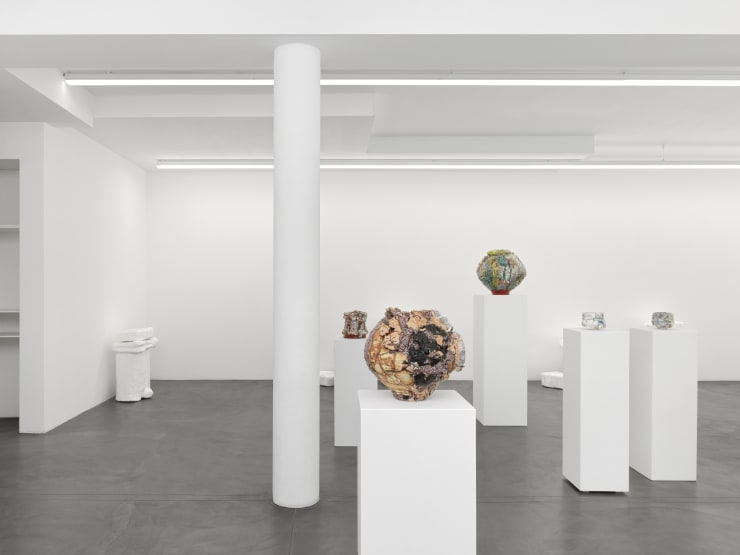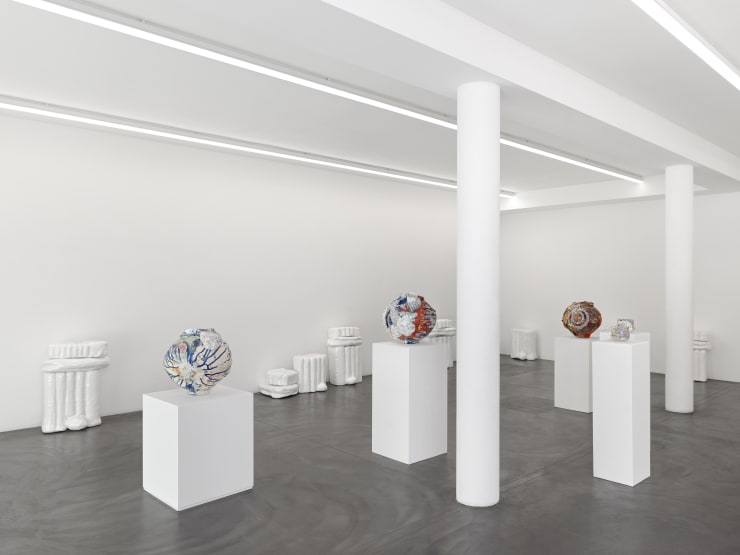In a moment where the boundaries between art, design, and craft continue to blur, Eidolon presents a nuanced examination of objecthood and function. Swiss-born Denis Savary and Kodai Ujiie, born in Japan, both approach object-making through a shared vocabulary of ambiguity, material play, and subtle references to domestic spaces. Although working in distinct mediums—Savary in resin and Ujiie in ceramic—both artists blur the boundaries between sculpture and design, producing works that are at once utilitarian and enigmatic. Their artistic backgrounds are deeply rooted in traditions of craft, where the ultimate mastery of technique is both a foundation and a threshold. It is this rigorous command of their materials that enables them to transcend convention, demonstrating that only by fully mastering an art can one truly command it.
Denis Savary’s Follies take on hybrid forms—part functional object, part sculpture, part architectural intervention—inviting a direct material encounter, which encourages viewers to engage both physically and visually, while simultaneously blurring long-established categories. Their engagement with domestic space and functional ambiguity nods toward the spatial interventions of Michael Asher—particularly his 1979 installation at Kunsthalle Bern—with their scale, placement, and utilitarian logic subtly shifting the viewer’s spatial awareness and altering the perceived function of the surrounding environment. The glossy, synthetic surfaces of Savary’s resin constructions lend the works an illusion of ceramics, conjuring a manufactured softness that oscillates between art object and functional décor. With their playful scale and material slipperiness, the pairs recall the tactile provocations of Franz West and the cartoon-like monumentality of Philip Guston’s late paintings. Working in resin allows for slick, translucent, or richly pigmented surfaces that dynamically shift in perceived materiality, while their modulable, usable nature invites activation by the viewer, following in West’s tradition and continuing a broader interrogation of what sculpture can be.
Rooted in traditional ceramics, Kodai Ujiie’s sculptures explore the evolving boundary between vessel and sculpture through controlled yet improvisational techniques. His pieces often evoke quiet, creature-like presences, drawing inspiration from the anatomical strangeness of amphibians and other biological oddities to create soft-edged forms that feel both familiar and otherworldly, resonating with a lineage of artists who expand the vessel into a sculptural language. Eschewing bold color, he employs a restrained, almost ghostly palette, with expressive forms and carefully worked surfaces reminiscent of experimental freedoms found in the work of Ron Nagle. Ujiie glazes suggest frozen, snow-covered terrains or ash-dusted mineral surfaces—distant, imagined, and quietly surreal landscapes. This muted, eerie tonality fosters a sense of reverie, creating a feeling of stillness or suspended time, as if each object inhabits a slow, parallel reality just beyond perception.
At the same time, Ujiie’s practice is deeply informed by the conventions of traditional Japanese pottery, particularly in his use of technical fusions that bridge historical methods with contemporary form. By adapting the kintsugi lacquer mending process, he brings a layered sensibility to his practice; his unpredictable glazes—thickly applied and often suggesting a synthetic gloss—conjure a striking sense of spontaneity within otherwise carefully constructed, deliberate forms. These works gesture toward utility, subtly alluding to conventional vessels or architectural fragments—recalling Betty Woodman’s reimagining of ceramic traditions through hybrid, architectonic gestures—while their meanings unfold through multiple layers of interpretation and ambiguity. His ceramics also evoke an animated quality: bulbous, soft-edged, almost creaturely forms that suggest narrative or anthropomorphic character, aligning with the expressive, sculptural approach of Ken Price and inviting viewers to engage with them as lively, enigmatic presences rather than mere objects.
Denis Savary and Kodai Ujiie work within a lexicon of the familiar, invoking a tension between the organic and the manufactured. It is through this familiarity that they challenge the role of the object in contemporary art, inviting viewers to question where function ends and form begins. Together, Savary and Ujiie extend a lineage of artists who reimagine objecthood as mutable, materially rich, and insistently in-between, finding echoes in broader sculptural dialogues. Constantly questioning imposed traditions, the dialogue between the two oeuvres compels us to reconsider our preconceptions of sculpture entirely.
—
Denis Savary (b. 1981, Switzerland) lives and works in Geneva, Switzerland.
His recent solo and group exhibitions include Nashville at KBCB Kunsthaus Biel Centre d'art Bienne, Switzerland (2025); Woman in Blue, Oskar Kokoschka and Alma Mahler, Museum Folkwang, Essen, Germany (2025); Quiet Clubbing at Centre d'édition contemporaine, Geneva, Switzerland (2024); Octogone with Chloé Delarue at Mayday, Basel (2023), Josy's Club with Pierre-Olivier Arnaud, Synagogue de Delme, Delme, France (2023); and The Puppet Show at Centre d’Art Contemporain Geneva, Switzerland (2022). He holds a BFA in Visual Arts from the Ecole Cantonale d’Art de Lausanne, ECAL (2004)
Kodai Ujiie (b. 1990, Japan) lives and works in Tajimi, Gifu, Japan.
His recent solo exhibitions include Skin and Body: Crazed Vessels at Ippodo Gallery, New York (2023) and Japanese Vanguard at The Stratford Gallery, UK (2022). Other notable presentations include exhibitions at Nihombashi Takashimaya S.C., Tokyo (2021) and Ippodo Gallery, Ginza (2019). Ujiie’s work is held in the collections of the Miyagi Prefectural Jun Sugimura Museum of Art in Japan and the Warehouse Art Museum in Milwaukee, Wisconsin. He holds a BFA and an MFA from Tohoku University of Art and Design (2013–2015).
 Kodai UjiieHybrid of Nezumi Shino and Oxblood Glaze Lacquer Large Jar Circle, 2025Ceramic, Lacquer48 x 42 x 44.3 cm
Kodai UjiieHybrid of Nezumi Shino and Oxblood Glaze Lacquer Large Jar Circle, 2025Ceramic, Lacquer48 x 42 x 44.3 cm Kodai UjiieHybrid of Ofuke and White Glaze Flower Painting Lacquer Tea Bowl, 2025Porcelain, Lacquer15.4 x 14.8 x 11.8 cm
Kodai UjiieHybrid of Ofuke and White Glaze Flower Painting Lacquer Tea Bowl, 2025Porcelain, Lacquer15.4 x 14.8 x 11.8 cm Kodai UjiieHybrid of Oribe and White Glaze Lacquer Water Jar, 2025Ceramic, Lacquer25 x 23.5 x 23 cm
Kodai UjiieHybrid of Oribe and White Glaze Lacquer Water Jar, 2025Ceramic, Lacquer25 x 23.5 x 23 cm Kodai UjiieWhite Porcelain Lacquer Tea Bowl , 2025Porcelain, Lacquer13.3 x 14 x 11.7 cm
Kodai UjiieWhite Porcelain Lacquer Tea Bowl , 2025Porcelain, Lacquer13.3 x 14 x 11.7 cm Kodai UjiieHybrid of Ofuke and White Glaze Lacquer Large Jar Twins Celadon Bowl , 2024Ceramic, Lacquer50 x 46 x 48.5 cm
Kodai UjiieHybrid of Ofuke and White Glaze Lacquer Large Jar Twins Celadon Bowl , 2024Ceramic, Lacquer50 x 46 x 48.5 cm Kodai UjiieHybrid Of Ofuke And White Glaze Lacquer Large Jar Twins White Glaze Tea Bowl, 2025Ceramic, Lacquer48 x 48 x 44 cm
Kodai UjiieHybrid Of Ofuke And White Glaze Lacquer Large Jar Twins White Glaze Tea Bowl, 2025Ceramic, Lacquer48 x 48 x 44 cm Kodai UjiieOribe Transfer Flower Painting Lacquer Large Jar, 2025Ceramic, Lacquer45 x 45 x 44 cm
Kodai UjiieOribe Transfer Flower Painting Lacquer Large Jar, 2025Ceramic, Lacquer45 x 45 x 44 cm Denis SavaryFollies, 2025Resin, paint
Denis SavaryFollies, 2025Resin, paint Denis SavaryFollies, 2025Resin, paintEach approx. 75 x 50 x 50 cm
Denis SavaryFollies, 2025Resin, paintEach approx. 75 x 50 x 50 cm Denis SavaryFollies, 2025Resin, paintapprox. 75 x 50 x 50 cm
Denis SavaryFollies, 2025Resin, paintapprox. 75 x 50 x 50 cm Denis SavaryFollies, 2025Resin, paintEach approx. 75 x 50 x 50 cm
Denis SavaryFollies, 2025Resin, paintEach approx. 75 x 50 x 50 cm Denis SavaryFollies, 2025Resin, paintEach approx. 75 x 50 x 50 cm
Denis SavaryFollies, 2025Resin, paintEach approx. 75 x 50 x 50 cm Denis SavaryFollies, 2025Resin, paintEach approx. 75 x 50 x 50 cm
Denis SavaryFollies, 2025Resin, paintEach approx. 75 x 50 x 50 cm Denis SavaryFollies, 2025Resin, paintapprox. 75 x 50 x 50 cm
Denis SavaryFollies, 2025Resin, paintapprox. 75 x 50 x 50 cm